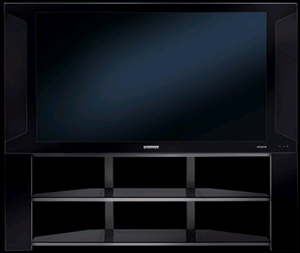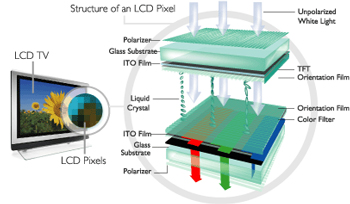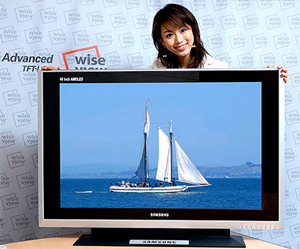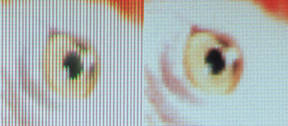|
LCD Format (Liquid Crystal Display) PCWorld: Plasma vs. LCD vs. LED: Which HDTV Type is Best?
LCD's are probably best known for their use with personal computers, replacing the small CRT monitors. This provides the user with a smaller desktop footprint. However, the technology has now evolved to larger displays for in-home television applications, in this configuration called LCD/TV's. For a smaller apartment, the LCD/TV can save space by being hung on a wall or doubling for computer displays. But it can have a serious price tradeoff when compared to the CRT format. Many LCD/TV's have HDTV compatibility with progressive scan to minimize display of scan lines on the enlarger LCD screen, but may lose those features when showing a standard NTSC broadcast or typical DVD RF output and not component outputs when available on your playback unit. In less technical words, when you're TV is connected by only an RF cable to a DVD player, you wouldn't get the best picture. ____________________________________ How It Works In simple terms, the LCD/TV format uses two thin, polarized glass panels (see below) that are sandwiched in a thin liquid-crystal gel, and manufactured into individual inline pixels similar to the phosphorous pattern you would find on the inside surface of inline CRT's. An X/Y grid of technically thinned wires allows each pixel in the array to be electronically activated on demand through a matrix of thin-film transistors (TFT) that feed instantly changing voltages to each pixel.
Similar with Plasma panels, a trio of red, green, and blue cells make up one pixel. When hit with an electrical charge, the liquid-crystal gels "untwisted" to an exact degree to filter light that has been generated by a lamp located behind the entire length and width of the flat LCD screen. When an LCD pixel darkens, it is being polarized at a 90-degree angle to the sandwiching polarizing screen, a process known as cross-polarizing. This blocks the constant background light from passing through the LCD screen at the position of the darkened pixel, providing the image with continuous contrasting lights and darks. A low voltage can be applied to a pixel to instantly make it look brighter, while a higher voltage darkens it again. Yet a slight bit of background light will always penetrate even the blackest LCD pixels. But if the image size is kept within design limitations, LCD/TV's will always display reasonable blacks, some say even slightly better than Plasma TV's based on current technology as of this writing (2005.)
The resolution of an LCD/TV display, regardless of size, at this writing is either 1280x768 or 1280x720, which is the same for the Digital Light Processing (DLP) format that will be covered later in Chapter 11. This makes LCD's capable of displaying 720p HDTV at full resolution (1280x720), the "p" standing for progressive scan. Current LCD technology requires that the highest HDTV resolution, 1080i (1920x1080), must be "downsampled" (called scaling) to meet the LCD's limited capabilities of faithfully reproducing the image provided. During this "downsampling," the interlaced 1080i input signal must be converted to the progressive 720p format, called the LCD's "Native Resolution." (See glossary in Chapter 17.) Please check with each manufacturer, as patented technology can change in proportion to the amount of money that is pulled out of your wallet. Lower resolutions from non-HDTV signals such as cable, DVD's, and VCR's must be, on the other hand, "upsampled" to again meet the required LCD's Native Resolution. As with Plasma and DLP devices, the built-in quality of the scaling has a direct impact on the image's quality, which translates into why some LCD/TV's will cost you more if displaying a better image.
____________________________________
The life span of the backlight is also important when buying an LCD/TV. Life span is the number of viewing hours before the back light dims to half brightness, and one of the biggest disadvantages the LCD format has over Plasma at the time of this writing. Though these estimates may vary among the different brands, LCD/TV sets are said to last for up to 60,000 hours. In comparison, older plasma displays would generally last to around 20,000 hours. New ones are said to be also rated now at the higher hours, but as always, buyer beware! Be sure to ask to see the manufacturer's specs before purchasing your LCD or Plasma TV, and see if you can also even get it in writing. HDTV sets aren't flying off the wall these days and you might grab an older version especially when buying online, which we rarely recommend for a large purchase. While 60,000 hours sound like a lot, let's check out the figure. If you ran your LCD set every hour of the day, 60,000 hours would equal about seven years. Of course, that wouldn't matter to me as I know I wouldn't want an image at half light from when I bought the set originally, since brightness is critical to all wide-screen HDTV televisions for best contrast and image detail. My bet is you wouldn't like an image at half light, either. But there is more. As the backlight dims it also changes its "whiteness," affecting the white balance of the picture . . . that is where the image could start to shift away from whites to whites that are slightly pink or blue. If you have owned a color television set that is at least 10-years old, you know what I'm talking about, the projected image having a slight reddish or bluish tint look to the overall picture. In the case of your old television set, replacing the picture tube was the only solution, pardon the pun, clearing up the picture. Of course, with new standard non-HDTV television sets being so inexpensive and in-home repair being very expensive, (or if even available), today you would simply replace the old set with a new one, someone building a house on your old one twenty years from now. When your picture starts to dim, you'll obviously want to replace the backlight then, as I would. When buying an LCD/TV you need to check to be sure that 1.) that a replacement is possible on the set you are buying, not making it obsolete, and 2.) "How much is that repair going to cost me, Dude?" For video game use, both products are considered to perform equally when an available DVI port is used. So if this is important to you, be sure to check the jack-pack on the back of the set or any optional inputs on the front. Either check the customer instruction manual being sure it matches the model number of the set you are looking at, to see a picture of the jack pack. Or you can get on your knees and look behind the set yourself that is displayed on the floor. Never trust the salesperson. They may not know and someone may had said to them, "Yea, its got that." If you need to see again what the DVI input jack looks like, go back to Chapter 8. LCD/TV's feature high brightness and flicker-free resolution capable of 16.7 million colors. Using a TFT active matrix, LCD/TV monitors can display superior pictures that are enhanced by a non-glare screen and wide-viewing angle for more viewing enjoyment. Sharp is supposed to be introducing a new reflective LCD technology that you may want to check out before finalizing your LCD/TV purchase. While LCD/TV's are available in many screen sizes, large screen sizes really start at 32-inch diagonal and expand to around 65-inch diagonal screens. Current pricing for larger HDTV LCD/TV's screens runs as much as $1,800 for a 22-inch diagonal wall-hanging unit and up to $3,500 for a 32-inch diagonal model. Some units using larger screen sizes can easily reach beyond $7,000. The viewing angle on LCD/TV's is at least 160 degrees, some manufacturers boasting 170 degrees. If you need more, (179 degrees max), because your television viewing room is long with some viewing angles would be near to the edge of the screen, you might want to check out the Plasma format. When you're expecting many friends to watch national sporting events on the weekends, the ones sitting near the sides of the set will thank you for researching this valuable wide-screen specification before you bought your set.
Some of the negative things you should check out before buying any HDTV LCD/TV is to be sure you personally don't see the potentially irritating "backdoor screen effect" on the screen (see illustration on the left) due to the arrangement of the LCD's inline pixels. Also, some LCD/TV's may at rare times show a ghosting effect on the screen, a result of the LCD/TV circuit not being able to keep up with fast changing images, the last image just going away as the next one is appearing. And again, check on the price of replacing the backlight panel, which can be expensive or make the LCD obsolete if difficult to remove. Get it in writing, as four years from now, let alone four days, the salesperson who sold you the set is going to forget what was promised if they even still are employed at the store where you purchased the unit. While the panel is recommended to be replaced at its half-light value, we've already discussed the downside to that concept. In addition, check out the picture contrast. If you don't see real black, blacks, move onto to another manufacturer's model or another format. Finally, as previously mentioned, some manufacturers may have eliminated the downsampling needed, since the LCD technology will currently not display the higher 1080i resolution. That would probably be the preferred model if it doesn't break the bank. As always, the picture is what you get, so always be happy with the image you are looking at, asking what is the source of the picture you are seeing on the sales floor. If you can't duplicate the source at home, you will not get the same picture quality you are seeing on the display floor. And that would be a bummer. And as I say with all HDTV projection sets that are not CRT's, check out what audio, if any, comes with the set and if you will need to buy a supplemental audio system to create the kind of stereo sound you are looking for to go with the new larger picture. It could add at least another $800 or more to the price of your purchase. In addition, check out the all-important jack-pack to see what kind and how many inputs and outputs you have available to you to use when you get home. And also be sure the LCD set you're buying is HDTV-Ready. If it isn't, you will not have the needed jacks on the back to connect your cable provider's digital HDTV converter box. On the other hand, if you're buying your LCD/TV to pick up on-air broadcast HDTV signals only, you will need a built-in HDTV tuner or will need to at least purchase one. In that case your HDTV set must be HDTV-Ready as explained above, to accept the outputs from the external add-on tuner module. In a later chapter, you will see a picture of my Sony's jack-pack that is just simply amazing in its flexibility, my using all but two of the inputs. For more information on the LCD/TV format, please visit the following site sponsored by the LCD TV Buying Guide. Finally, read the technology report in the Chapter on DLP technology, which describes the drawbacks of the LCD format when compared to the DLP. One final comment about the LCD's competitive format, Plasma, in case you miss it in the next Chapter.
___________________________________ ___________________________________
|
|
Index
|
|
Index
|



